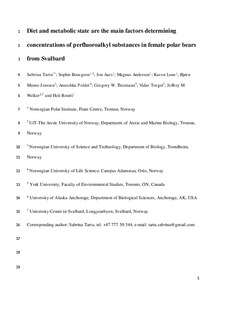Diet and metabolic state are the main factors determining concentrations of perfluoroalkyl substances in female polar bears from Svalbard
| dc.contributor.author | Tartu, Sabrina | |
| dc.contributor.author | Bourgeon, Sophie | |
| dc.contributor.author | Aars, Jon | |
| dc.contributor.author | Andersen, Magnus | |
| dc.contributor.author | Lone, Karen | |
| dc.contributor.author | Jenssen, Bjørn Munro | |
| dc.contributor.author | Polder, Anuschka | |
| dc.contributor.author | Thiemann, Gregory W. | |
| dc.contributor.author | Torget, Vidar | |
| dc.contributor.author | Welker, Jeffrey Martin | |
| dc.contributor.author | Routti, Heli Anna Irmeli | |
| dc.date.accessioned | 2017-06-16T11:16:43Z | |
| dc.date.available | 2017-06-16T11:16:43Z | |
| dc.date.created | 2017-06-12T10:52:32Z | |
| dc.date.issued | 2017 | |
| dc.identifier.citation | Environmental Pollution. 2017, 229 146-158. | nb_NO |
| dc.identifier.issn | 0269-7491 | |
| dc.identifier.uri | http://hdl.handle.net/11250/2446242 | |
| dc.description.abstract | Perfluoroalkyl substances (PFASs) have been detected in organisms worldwide, including Polar Regions. The polar bear (Ursus maritimus), the top predator of Arctic marine ecosystems, accumulates high concentrations of PFASs, which may be harmful to their health. The aim of this study was to investigate which factors (habitat quality, season, year, diet, metabolic state [i.e. feeding/fasting], breeding status and age) predict PFAS concentrations in female polar bears captured on Svalbard (Norway). We analysed two perfluoroalkyl sulfonates (PFSAs: PFHxS and PFOS) and C8-C13 perfluoroalkyl carboxylates (PFCAs) in 112 plasma samples obtained in April and September 2012–2013. Nitrogen and carbon stable isotope ratios (δ15N, δ13C) in red blood cells and plasma, and fatty acid profiles in adipose tissue were used as proxies for diet. We determined habitat quality based on movement patterns, capture position and resource selection functions, which are models that predict the probability of use of a resource unit. Plasma urea to creatinine ratios were used as proxies for metabolic state (i.e. feeding or fasting state). Results were obtained from a conditional model averaging of 42 general linear mixed models. Diet was the most important predictor of PFAS concentrations. PFAS concentrations were positively related to trophic level and marine diet input. High PFAS concentrations in females feeding on the eastern part of Svalbard, where the habitat quality was higher than on the western coast, were likely related to diet and possibly to abiotic factors. Concentrations of PFSAs and C8-C10 PFCAs were higher in fasting than in feeding polar bears and PFOS was higher in females with cubs of the year than in solitary females. Our findings suggest that female polar bears that are exposed to the highest levels of PFAS are those 1) feeding on high trophic level sea ice-associated prey, 2) fasting and 3) with small cubs. | nb_NO |
| dc.language.iso | eng | nb_NO |
| dc.publisher | Elsevier | nb_NO |
| dc.rights | Attribution-NonCommercial-NoDerivatives 4.0 Internasjonal | * |
| dc.rights.uri | http://creativecommons.org/licenses/by-nc-nd/4.0/deed.no | * |
| dc.title | Diet and metabolic state are the main factors determining concentrations of perfluoroalkyl substances in female polar bears from Svalbard | nb_NO |
| dc.type | Journal article | nb_NO |
| dc.type | Peer reviewed | nb_NO |
| dc.description.version | submittedVersion | nb_NO |
| dc.source.pagenumber | 146-158 | nb_NO |
| dc.source.volume | 229 | nb_NO |
| dc.source.journal | Environmental Pollution | nb_NO |
| dc.identifier.doi | 10.1016/j.envpol.2017.04.100 | |
| dc.identifier.cristin | 1475296 | |
| dc.description.localcode | © 2017 Elsevier Ltd. All rights reserved. This is the authors' manuscript to the article. Locked until 03 june 2019 due to copyright restrictions | nb_NO |
| cristin.unitcode | 194,66,10,0 | |
| cristin.unitname | Institutt for biologi | |
| cristin.ispublished | true | |
| cristin.fulltext | postprint | |
| cristin.qualitycode | 1 |
Files in this item
This item appears in the following Collection(s)
-
Institutt for biologi [2596]
-
Publikasjoner fra CRIStin - NTNU [38294]

